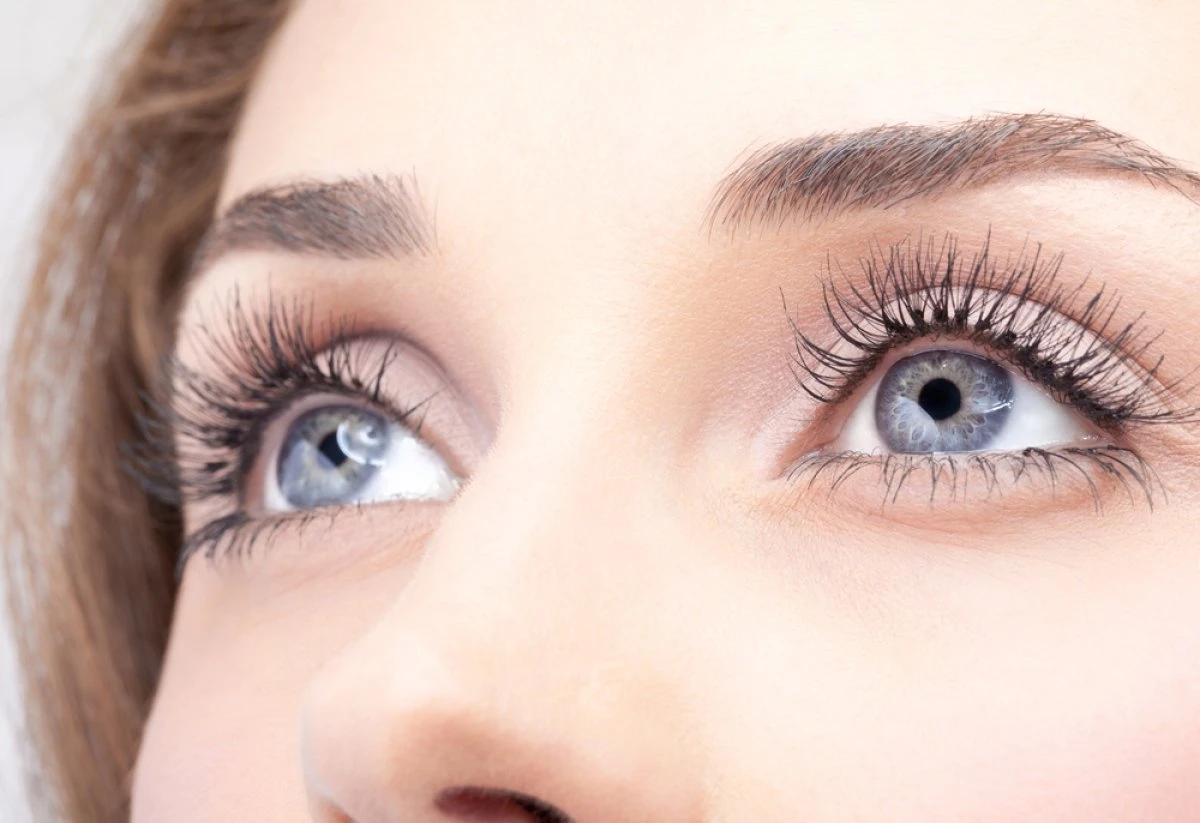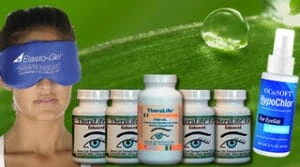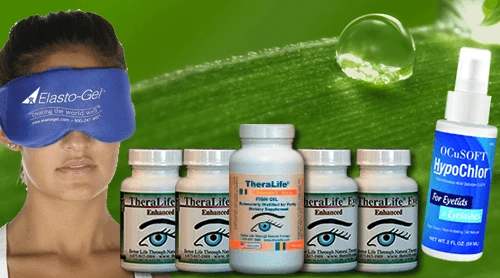Yes, stress can contribute to dry eye by impacting both your physiological and emotional well-being. Elevated cortisol levels during stress can reduce tear production and increase inflammation, exacerbating dry eye symptoms.
Moreover, stress can disrupt sleep and decrease your blink rate, leading to further ocular discomfort. Psychological distress can also heighten sensitivity to pain and dryness, creating a direct link between emotional health and the severity of dry eye.
TheraLife’s products are designed to address these symptoms by providing comprehensive solutions that improve tear production, reduce inflammation, and promote overall eye health.
By understanding the connection between stress and ocular health, you can explore TheraLife’s range of products to manage your symptoms effectively. These products are aimed at enhancing your lifestyle through natural and scientifically-backed remedies, empowering you to maintain optimal eye health and well-being.
Powerful Dry Eye Treatment – TheraLIfe
Oral dry eye treatment- All Natural. Sustainable, long lasting all day long.
Add To Cart
Key Takeaways
- Stress elevates cortisol levels, increasing inflammation and reducing tear production, worsening dry eye symptoms. TheraLife’s comprehensive range of products can help mitigate these effects by promoting better tear production and reducing inflammation.
- Emotional health and stress responses amplify sensitivity to pain and discomfort in dry eye disease. TheraLife’s targeted therapies address this by enhancing tear secretion and supporting overall eye health.
- Chronic stress disrupts sleep patterns, further degrading eye health and exacerbating dry eye symptoms. TheraLife offers solutions that work to restore natural tear balance, improving eye comfort even when sleep patterns are compromised.
- Stress-related behaviors, like reduced blinking, contribute to increased dryness and ocular discomfort. TheraLife’s products are designed to counteract these behaviors by providing sustained relief and encouraging natural tear production.
- Mindfulness and relaxation techniques can improve ocular health by reducing stress levels. TheraLife supports these holistic approaches with products that complement relaxation methods, ensuring comprehensive eye care.
Summary of TheraLife’s Benefits:
TheraLife provides a wide array of specialized products designed to treat various eye conditions, including blepharitis, dry eyes, uveitis, and more. These products help reduce inflammation, enhance natural tear production, and address underlying causes of discomfort. TheraLife’s holistic approach often includes dietary suggestions, natural treatments, and lifestyle adjustments to support eye health. Their solutions are particularly beneficial for those experiencing stress-related or chronic eye issues, as they offer effective, natural relief to improve overall eye wellness.
Understanding Dry Eye
When understanding dry eye, it’s vital to recognize that this chronic condition arises from either insufficient tear production or rapid tear evaporation, both of which can lead to significant discomfort and potential harm to the eye’s surface.
Dry eye disease (DED) can severely impact your eye health, with the tear film‘s three layers—mucus, watery, and oil—all playing important roles in maintaining eye moisture.
Aging and hormonal changes are common factors that can exacerbate dry eye, particularly in older populations where tear production naturally decreases.
Symptoms of dry eye include sensations of dryness, burning, irritation, blurry vision, and increased sensitivity to light.
These symptoms can be exacerbated by environmental factors such as wind, smoke, and prolonged screen time. Such conditions can compromise the tear film, leading to increased evaporation or reduced tear production, thereby perpetuating chronic dry eye.
Effective management of chronic dry eye involves targeting the underlying issues with tear production and retention.
Treatment options often include lubricating eye drops to supplement the tear film, prescription medications to address inflammation or increase tear production, and lifestyle adjustments to mitigate environmental triggers.
Stress and Ocular Health
Understanding the multifaceted causes of dry eye disease lays the groundwork for exploring how stress impacts ocular health.
Stress is a crucial factor that can exacerbate dry eye symptoms through several mechanisms. Elevated cortisol levels, a hallmark of stress, can reduce tear production, leading to increased dryness, redness, and blurred vision. Additionally, stress-induced inflammation can worsen dry eye symptoms, as white blood cells release inflammatory chemicals on the eye’s surface.
Studies show that chronic dry eyes are reported more frequently in patients undergoing depression treatment, indicating a notable interplay between mental health and ocular health.
Stress also impacts your mental health, which can indirectly affect your eyes. Poor sleep quality and stress-related behaviors, such as reduced blinking, markedly heighten dry eye discomfort.
Here’s how stress influences ocular health:
- Decreased Tear Production: Elevated cortisol levels reduce the eyes’ ability to produce tears, leading to dryness and irritation.
- Increased Inflammation: Stress triggers inflammatory responses, causing white blood cells to release chemicals that aggravate the ocular surface.
- Behavioral Changes: Stress often leads to behaviors like reduced blinking, contributing to the evaporation of tears and worsening dry eye symptoms.
Managing stress through relaxation techniques like yoga and deep breathing can help mitigate these effects, improving overall ocular health.
Symptoms of Dry Eye
You may notice common dry eye symptoms such as dryness, burning sensations, and gritty feelings, which can disrupt your daily life.
These symptoms are typically bilateral and persistently uncomfortable.
Visual discomfort, including blurry vision and light sensitivity, often worsens with prolonged screen exposure or environmental factors.
Additionally, excessive tearing, redness, and difficulty wearing contact lenses might occur, particularly under stress or with poor sleep.
Common Dry Eye Symptoms
Experiencing dry eye can be particularly distressing, manifesting through a range of symptoms that affect both comfort and vision. When stress exacerbates these symptoms, it becomes even more vital to identify and address them.
Common symptoms of dry eye include a persistent sensation of dryness, burning sensations, and a gritty or sandy feeling in the eyes. Psychological associations indicate that stress can impact the severity of dry eye symptoms, linking emotional health to ocular conditions. These symptoms can notably disrupt your daily activities and overall quality of life.
From a clinical perspective, it’s important to recognize the following common indicators of dry eye disease:
- Visual Disturbances: Blurred vision and increased sensitivity to light are frequent complaints that can impair your ability to see clearly.
- Physical Discomfort: You might experience eye fatigue and difficulty wearing contact lenses, which can worsen your comfort levels.
- Paradoxical Tearing: Excessive tearing can paradoxically occur as a response to irritation, leading to confusion about the condition’s symptoms.
Understanding these symptoms can help you seek appropriate treatment and manage the condition effectively. If you notice any of these signs, consider consulting a healthcare professional to explore potential causes and solutions.
Effective management can notably improve both your ocular health and emotional well-being.
Visual Discomfort Indicators
Visual discomfort is a hallmark symptom of dry eye disease, often manifesting as blurred vision and heightened sensitivity to light. When your tear film is disrupted, it can lead to a range of uncomfortable symptoms.
You might experience a gritty or sandy sensation in your eyes, making it feel like there’s a foreign object present. This discomfort is exacerbated by the dryness and burning sensations commonly reported by those with dry eyes. Stress can cause dry eye by altering tear production, leading to these visual discomforts.
You’ll notice your vision becoming blurred, especially during prolonged activities like reading or using a computer. Increased sensitivity to light, or photophobia, may make you squint or avoid bright environments altogether.
Additionally, irritation and redness can occur, sometimes alongside excessive tearing. This paradoxical response happens as your eyes attempt to compensate for the dryness.
Wearing contact lenses might become increasingly difficult, as the tear film that normally keeps them comfortable is compromised. Without adequate intervention, these symptoms can escalate, potentially leading to corneal damage and a heightened risk of infections.
Understanding these indicators will help you recognize and address the underlying issues causing your visual discomfort. For those seeking a natural alternative, TheraLife Eye capsules offer a clinically proven solution to improve tear production and reduce dryness symptoms.
Frequent Dry Eye Signs
Several telltale signs frequently indicate the presence of dry eye disease. When you experience dry eyes, you might notice persistent sensations of dryness, burning, or a gritty feeling, as if there’s sand in your eyes.
These symptoms are often exacerbated by stress and poor sleep quality, contributing to the overall discomfort and eye problems. Additionally, conditions like thyroid disorders and Sjögren’s syndrome can intensify symptoms, making effective eye care even more critical.
Clinically, the following are common indicators of dry eye disease:
- Visual Disturbances: Blurry vision and increased sensitivity to light can make daily activities challenging.
- Excessive Tearing: Paradoxically, your eyes may produce excessive tears in response to irritation, often accompanied by mucus discharge.
- Contact Lens Discomfort: Many individuals with dry eyes find it difficult to wear contact lenses comfortably, particularly noticing a worsening of symptoms at night.
Redness and irritation are also frequent, sometimes leading to additional symptoms like excessive tearing and discomfort.
The variability in severity and frequency of these symptoms can greatly impact your quality of life, making effective eye care essential. Understanding these signs can help you recognize and address dry eye disease early, potentially mitigating the exacerbating effects of stress and improving your overall eye health.
Impact of Stress on Symptoms
Heightened by the body’s stress response, sensitivity to pain can greatly amplify the discomfort and irritation in your eyes, making the sensation of dryness more pronounced.
Stress can cause a range of physiological changes that directly impact your ocular health. When you’re stressed, your body may produce fewer tears, leading to increased tear evaporation and consequently, more severe dry eye symptoms. This can exacerbate the feeling of dryness, irritation, and even lead to ocular fatigue.
Furthermore, stress can also contribute to conditions like blepharitis and meibomian gland dysfunction, further impacting tear quality and stability.
Additionally, stress commonly interferes with your sleep patterns. Lack of sleep considerably worsens dry eye symptoms by reducing the quality and quantity of tears your eyes produce. Inadequate rest also compromises your body’s ability to repair and maintain ocular tissues, further deteriorating your eye health.
Additionally, medications prescribed for anxiety, depression, and insomnia often have side effects that contribute to dry eyes. Understanding these side effects is essential as they can provide insights into the worsening of dry eye symptoms.
Decreased tear production and increased sensitivity to discomfort create a feedback loop that perpetuates the cycle of stress and ocular irritation. By recognizing the impact of stress on symptoms, you can better manage your overall ocular health.
Managing Dry Eye Symptoms
When managing dry eye symptoms, taking regular breaks from screen time is essential, as prolonged digital exposure can greatly worsen discomfort and dryness. The blue light emitted by screens can strain your eyes, decreasing blink rates and leading to tear evaporation.
Dry eye disease is a condition that affects millions globally, often leading to chronic discomfort and impaired vision if not managed properly. Here’s a structured approach to help alleviate your symptoms:
- Eye Drops: Incorporate moisturizing eye drops into your routine. These can help maintain hydration and protect against environmental stressors that exacerbate dryness.
- Hydration and Wind Exposure: Guarantee you stay well-hydrated and limit exposure to windy conditions. Adequate hydration and protection from wind contribute to tear film stability, reducing the severity of dry eye.
- Warm Compresses and Massages: Use warm eye compresses and gentle eyelid massages to improve lubrication and disperse natural oils. This practice can provide significant relief from dryness and irritation.
Additionally, practicing self-care can be beneficial. Techniques such as yoga and deep breathing exercises help manage stress and dry eye symptoms, enhancing overall eye comfort.
Recommended Relief Techniques
To alleviate dry eye symptoms, you can start with warm eye compresses, which enhance lubrication by promoting oil secretion from the meibomian glands.
Using a hot compress for eyes can be particularly effective for improving gland function and providing relief from crusty, sticky, or runny eyes.
Gentle eyelid massages are also effective, as they disperse natural oils and improve tear film stability.
Incorporating these techniques into your daily routine can provide significant relief from dryness and irritation.
Warm Compress Benefits
Applying warm compresses offers significant benefits for individuals suffering from dry eye disease. This simple yet effective home remedy can enhance lubrication by increasing blood circulation to the eyelids and meibomian glands, which are essential for tear production.
When you apply warm compresses, the heat helps to melt any blocked oil in the meibomian glands, thereby improving the quality of your tear film and reducing dry eye symptoms. Studies suggest that warmth applied to the eyes leads to a significant reduction in symptoms of dry eye, including improved tear stability and overall comfort.
Consistent application of heat is vital for better results; multiple applications per day enhance effectiveness. Here are three key benefits:
- Enhanced Tear Production: Warm compresses stimulate the meibomian glands, which release oils that are necessary for maintaining a healthy tear film.
- Alleviation of Discomfort: Regular application can soothe irritation and reduce inflammation, providing much-needed relief from the discomfort associated with dry eye.
- Ease of Use: This technique is straightforward and can be seamlessly integrated into your daily routine, making it a practical and effective at-home remedy.
Incorporating warm compresses into your daily regimen can be an excellent strategy to manage dry eye symptoms and improve your overall eye health.
Eyelid Massage Techniques
Eyelid massage techniques offer a clinically proven method to improve tear film stability and alleviate dry eye symptoms. Gentle eyelid massages can help disperse natural oils from the meibomian glands, enhancing lubrication on the ocular surface. This process is essential for managing dry eye symptoms effectively.
Regularly performing eyelid massages stimulates blood flow and can reduce inflammation on the eyelid margins, which is often associated with dry eye disease.
To maximize benefits, consider performing eyelid massages after applying warm compresses. This combination enhances the effectiveness of both techniques, providing much-needed relief from dryness and irritation.
Always use clean fingers or a specialized eye massage tool to guarantee hygiene and prevent introducing irritants to the sensitive ocular surface.
Incorporating eyelid massages into your daily routine can greatly enhance overall ocular health. By proactively addressing the effects of stress through these massages, you can better manage dry eye symptoms and maintain ideal eye comfort.
Make it a habit to include these massages in your self-care regimen, focusing on gentle, consistent pressure to achieve the finest results. This practice not only alleviates discomfort but also promotes long-term ocular well-being.
Preventive Measures
Ever wondered how you can effectively prevent dry eye symptoms, especially when stress is a contributing factor? Managing your stress levels and adopting preventive measures can provide significant relief. Here are some scientifically-backed strategies to help:
- Take regular breaks: Prolonged screen time can strain your eyes and exacerbate dryness. Implement the 20-20-20 rule—every 20 minutes, look at something 20 feet away for 20 seconds. This reduces eye strain and supports tear production.
- Stay hydrated: Adequate water intake is essential for maintaining proper eye lubrication. Dehydration can worsen dryness, so aim to drink at least eight glasses of water daily. This simple habit can help prevent dry eye symptoms.
- Use humidifiers: Dry environments can lead to quicker tear evaporation. Utilizing humidifiers, especially in your workspace or home, maintains moisture levels in the air, which is fundamental for overall ocular health.
Additionally, relaxation techniques such as yoga and meditation can lower your stress levels, indirectly reducing the risk of dry eye.
Limiting exposure to irritants like wind and smoke, and wearing sunglasses outdoors, also play a role in preventing dryness and discomfort.
Eye Care in Modern Life
Understanding how to prevent dry eye symptoms by managing stress naturally leads us to explore the broader aspects of eye care in modern life.
Modern lifestyles, marked by prolonged screen use and work-related stress, greatly contribute to increased eye strain and discomfort. Research shows that around 8% of the U.S. population suffers from dry eye disease, often exacerbated by stress and poor self-care.
Stress can affect your ocular health by causing inflammation and reducing tear production. Prolonged screen time is a primary cause of eye strain, leading to symptoms like dryness, redness, and irritation.
Simple lifestyle changes can help mitigate these effects. Taking regular breaks from digital devices, staying hydrated, and incorporating stress-relief activities such as yoga and regular exercise are effective treatment options to improve eye health.
Prioritizing eye care by integrating mindfulness practices into your daily routine can help reduce stress and maintain ideal ocular health.
Adopting these evidence-based strategies won’t only alleviate stress-related eye issues but also enhance your overall well-being.
Frequently Asked Questions
Can Emotional Stress Affect Your Eyes?
Yes, emotional stress can affect your eyes. Stress hormones like cortisol can disrupt tear production, leading to dry eyes.
Anxiety can reduce blinking, worsening dry eye symptoms. Poor emotional well-being is also linked to increased eye pain sensitivity. Managing stress is crucial for maintaining eye health.
TheraLife offers effective solutions for these issues. Their products support tear production and overall ocular health, helping to mitigate the impact of stress on the eyes.
With TheraLife, customers can find relief from conditions like blepharitis, dry eyes, and uveitis through natural treatments and lifestyle adjustments.
Managing stress through TheraLife’s comprehensive eye care solutions ensures optimal eye function and comfort.
What Emotions Are Behind Dry Eyes?
Emotional triggers like anxiety and depression are key contributors to dry eyes. Stress responses can cause eye fatigue and exacerbate dryness.
Effects of anxiety include reduced blinking and increased screen time, both leading to discomfort. Elevated cortisol levels from stress induce inflammation, worsening symptoms.
TheraLife’s products are designed to address these issues effectively. By incorporating natural remedies and targeted treatments, TheraLife helps manage emotional triggers and improve eye health.
Their comprehensive solutions, such as those found in their blepharitis treatment and anti-inflammatory diet plans, offer relief from symptoms and support overall eye well-being.
Utilizing TheraLife’s products can significantly enhance comfort and eye health, making it easier to cope with the emotional triggers that contribute to dry eyes.
Can Dry Eyes Be Psychosomatic?
Yes, dry eyes can be psychosomatic. Stress and emotional triggers like anxiety can lead to dry eye disease.
TheraLife’s products address these symptoms by focusing on holistic health. TheraLife offers a range of solutions that not only target the physical symptoms of dry eyes but also emphasize stress management and emotional well-being.
How to Cope With Severe Dry Eyes?
To cope with severe dry eyes, consider integrating TheraLife‘s comprehensive products and solutions into your routine.
TheraLife offers a range of evidence-based products designed to alleviate the symptoms of dry eyes, blepharitis, and other eye conditions. Their targeted treatments, including natural supplements, have shown clinical efficacy in enhancing tear production and reducing inflammation.
These products are complemented by lifestyle recommendations such as the 20-20-20 rule, hydration tips, and a focus on omega-3 fatty acids to support overall eye health.
Conclusion
Stress, much like Pandora’s box, can unleash various symptoms affecting your ocular health, including dry eye. By understanding this connection, you can better manage and mitigate these effects. TheraLife’s products offer effective relief and preventive measures, empowering you to maintain optimal eye health amid life’s challenges. Remember, your emotional well-being is intertwined with your physical health, making it essential to address both for comprehensive care. TheraLife’s range of solutions, from natural treatments for blepharitis and uveitis to specialized eye care for conditions like Sjogren’s syndrome, provides holistic and targeted support for your eye health needs.
References
1.
2.
3.
4.
5.
6.
7.
8.
9.
10.
11.
12.
13.
14.
15.
16.
17.
18.
19.
20.





